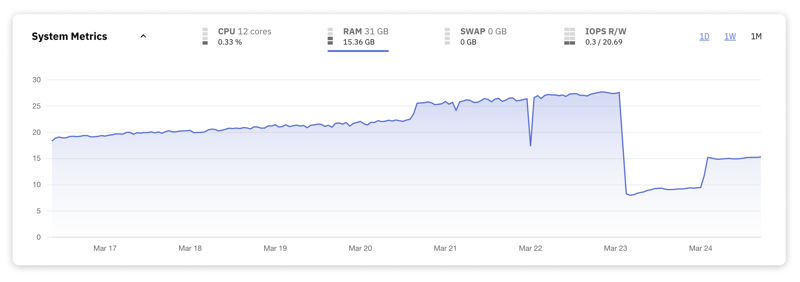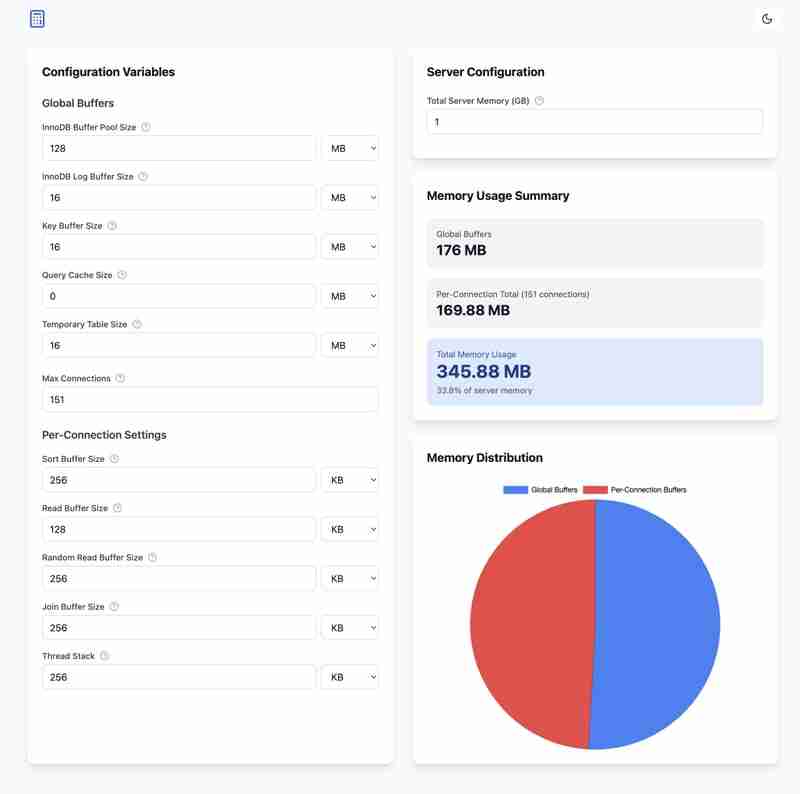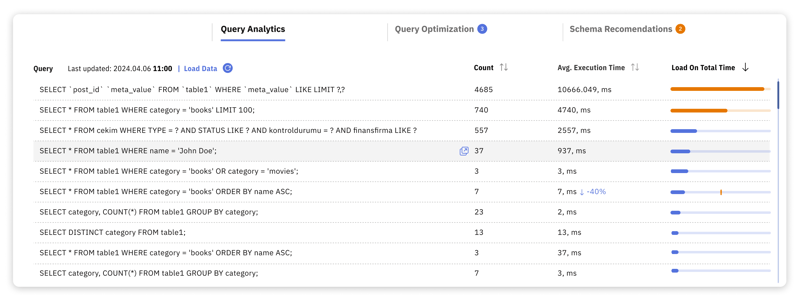MySQL Memory Usage: Optimization Guide
MySQL Memory Optimization Guide: Avoid Memory Peaks and Improve Database Performance
High MySQL memory usage will seriously affect database speed and reliability. This article will explore the MySQL memory management mechanism in depth and provide best practices to help you optimize performance and avoid memory bottlenecks.

MySQL memory usage analysis
MySQL dynamically allocates memory for handling queries, connections, and performance optimizations. It is mainly divided into two categories:
1. Global buffer: shared by the entire MySQL server, including InnoDB buffer pool, key buffer and query cache, etc. InnoDB buffer pool is particularly important. It caches frequently accessed data and indexes, speeds up query speed, but it will occupy a lot of memory when the data volume is large.
2. Connection (per thread) buffer: Allocate independent memory for each client connection, including sorting buffers, connection buffers, and temporary table memory. The more concurrent connections, the greater the memory consumption, which is particularly critical in high-traffic environments.
Common Causes of MySQL Memory Rises
MySQL memory peaks are usually caused by the following factors:
- High Concurrent Connections and Large Buffers: If the sort or connection buffer is set too large, a large number of concurrent connections can quickly run out of memory.
- Complex queries: Complex queries (large joins, subqueries, or large number of temporary tables) temporarily occupy a lot of memory, especially when query optimization is insufficient.
- InnoDB buffer pool setting is too large: If the InnoDB buffer pool size exceeds the available memory on the server, disk swap will be frequently performed, seriously degrading performance.
- Large temporary tables: When temporary tables exceed memory limit (
tmp_table_size), they will be written to disk, reducing speed and increasing resource consumption. - Inefficient indexing: Lack of appropriate indexes can lead to full table scanning, and even moderately complex queries can increase memory and CPU usage.
MySQL memory optimization best practices
To deal with excessive MySQL memory usage, try the following strategies:
1. Optimize the global buffer:
- Set
innodb_buffer_pool_sizeto 60%-70% of the available memory of InnoDB workloads. For smaller loads, it should be reduced appropriately. - Keep
innodb_log_buffer_sizeat a practical size (e.g. 16MB), unless the write-intensive workload requires more. - Adjust
key_buffer_sizeaccording to the usage of MyISAM table to avoid unnecessary memory allocation.
2. Resize the connection buffer:
- Reduce
sort_buffer_sizeandjoin_buffer_sizeto balance memory usage and query performance, especially in high concurrency environments. - Optimize
tmp_table_sizeandmax_heap_table_sizeto control temporary table memory allocation and avoid frequent disk usage.
3. Fine-tune table cache:
- Adjust
table_open_cacheto avoid bottlenecks while taking into account operating system file descriptor limitations. - Configure
table_definition_cacheto effectively manage table metadata, especially in environments where there are many tables or complex foreign key relationships.
4. Control thread cache and connection restrictions:
- Reuse threads with
thread_cache_sizeto reduce the overhead of creating threads. - Adjust
thread_stackandnet_buffer_lengthto fit the workload while keeping memory usage scalable. - Limit
max_connectionsto a reasonable range to prevent too many session buffers from occupying too much server memory.
5. Monitor and optimize temporary tables:
- Monitor the usage of temporary tables and reduce memory pressure by optimizing queries such as
GROUP BY,ORDER BY, orUNION.
6. Using MySQL Memory Calculator:
- Estimate memory usage using tools such as Releem's MySQL memory calculator. Enter the MySQL configuration value and the calculator will display the maximum memory usage in real time, which will help to allocate resources effectively.

7. Monitor query performance:
- Queries with high memory consumption (large number of joins or sorts, lack of indexing) can affect memory usage. Use Releem's query analysis and optimization functions to identify inefficient queries for further optimization.

Simplify MySQL memory tuning with Releem
Releem simplifies the MySQL optimization process by automatically analyzing settings and suggesting configuration changes that meet memory limitations and performance requirements. Whether it is complex workloads or time-critical situations, Releem can help you keep MySQL running smoothly. To learn more about Releem's features, please visit its official website.
The above is the detailed content of MySQL Memory Usage: Optimization Guide. For more information, please follow other related articles on the PHP Chinese website!

Hot AI Tools

Undresser.AI Undress
AI-powered app for creating realistic nude photos

AI Clothes Remover
Online AI tool for removing clothes from photos.

Undress AI Tool
Undress images for free

Clothoff.io
AI clothes remover

Video Face Swap
Swap faces in any video effortlessly with our completely free AI face swap tool!

Hot Article

Hot Tools

Notepad++7.3.1
Easy-to-use and free code editor

SublimeText3 Chinese version
Chinese version, very easy to use

Zend Studio 13.0.1
Powerful PHP integrated development environment

Dreamweaver CS6
Visual web development tools

SublimeText3 Mac version
God-level code editing software (SublimeText3)

Hot Topics
 1655
1655
 14
14
 1414
1414
 52
52
 1307
1307
 25
25
 1253
1253
 29
29
 1227
1227
 24
24
 MySQL and phpMyAdmin: Core Features and Functions
Apr 22, 2025 am 12:12 AM
MySQL and phpMyAdmin: Core Features and Functions
Apr 22, 2025 am 12:12 AM
MySQL and phpMyAdmin are powerful database management tools. 1) MySQL is used to create databases and tables, and to execute DML and SQL queries. 2) phpMyAdmin provides an intuitive interface for database management, table structure management, data operations and user permission management.
 Explain the purpose of foreign keys in MySQL.
Apr 25, 2025 am 12:17 AM
Explain the purpose of foreign keys in MySQL.
Apr 25, 2025 am 12:17 AM
In MySQL, the function of foreign keys is to establish the relationship between tables and ensure the consistency and integrity of the data. Foreign keys maintain the effectiveness of data through reference integrity checks and cascading operations. Pay attention to performance optimization and avoid common errors when using them.
 SQL vs. MySQL: Clarifying the Relationship Between the Two
Apr 24, 2025 am 12:02 AM
SQL vs. MySQL: Clarifying the Relationship Between the Two
Apr 24, 2025 am 12:02 AM
SQL is a standard language for managing relational databases, while MySQL is a database management system that uses SQL. SQL defines ways to interact with a database, including CRUD operations, while MySQL implements the SQL standard and provides additional features such as stored procedures and triggers.
 Compare and contrast MySQL and MariaDB.
Apr 26, 2025 am 12:08 AM
Compare and contrast MySQL and MariaDB.
Apr 26, 2025 am 12:08 AM
The main difference between MySQL and MariaDB is performance, functionality and license: 1. MySQL is developed by Oracle, and MariaDB is its fork. 2. MariaDB may perform better in high load environments. 3.MariaDB provides more storage engines and functions. 4.MySQL adopts a dual license, and MariaDB is completely open source. The existing infrastructure, performance requirements, functional requirements and license costs should be taken into account when choosing.
 How does MySQL differ from Oracle?
Apr 22, 2025 pm 05:57 PM
How does MySQL differ from Oracle?
Apr 22, 2025 pm 05:57 PM
MySQL is suitable for rapid development and small and medium-sized applications, while Oracle is suitable for large enterprises and high availability needs. 1) MySQL is open source and easy to use, suitable for web applications and small and medium-sized enterprises. 2) Oracle is powerful and suitable for large enterprises and government agencies. 3) MySQL supports a variety of storage engines, and Oracle provides rich enterprise-level functions.
 Linux: A Deep Dive into Its Fundamental Parts
Apr 21, 2025 am 12:03 AM
Linux: A Deep Dive into Its Fundamental Parts
Apr 21, 2025 am 12:03 AM
The core components of Linux include kernel, file system, shell, user and kernel space, device drivers, and performance optimization and best practices. 1) The kernel is the core of the system, managing hardware, memory and processes. 2) The file system organizes data and supports multiple types such as ext4, Btrfs and XFS. 3) Shell is the command center for users to interact with the system and supports scripting. 4) Separate user space from kernel space to ensure system stability. 5) The device driver connects the hardware to the operating system. 6) Performance optimization includes tuning system configuration and following best practices.
 SQL: The Language, MySQL: The Database Management System
Apr 21, 2025 am 12:05 AM
SQL: The Language, MySQL: The Database Management System
Apr 21, 2025 am 12:05 AM
The relationship between SQL and MySQL is: SQL is a language used to manage and operate databases, while MySQL is a database management system that supports SQL. 1.SQL allows CRUD operations and advanced queries of data. 2.MySQL provides indexing, transactions and locking mechanisms to improve performance and security. 3. Optimizing MySQL performance requires attention to query optimization, database design and monitoring and maintenance.
 The Current macOS: Everything You Need to Know
Apr 27, 2025 am 12:16 AM
The Current macOS: Everything You Need to Know
Apr 27, 2025 am 12:16 AM
macOSSonoma is the latest version launched in 2023. 1) Enhanced video conferencing functions, support virtual backgrounds and reaction effects; 2) Improved game performance, support Metal3 graphics API; 3) Added new privacy and security features, such as lock mode and stronger password protection.




